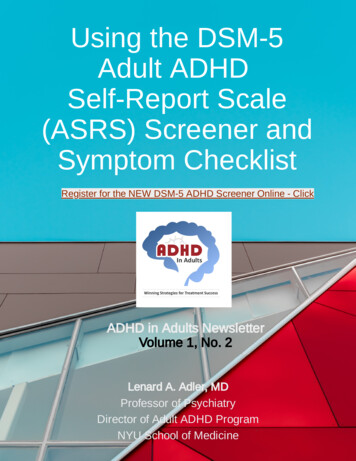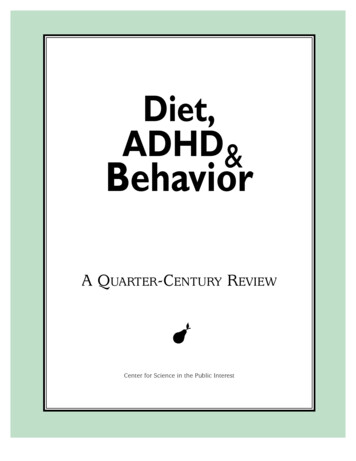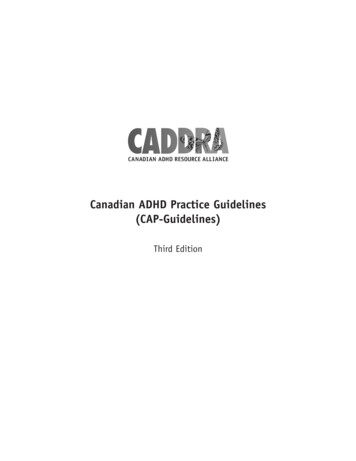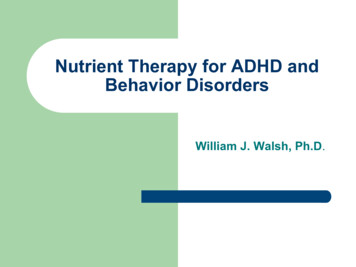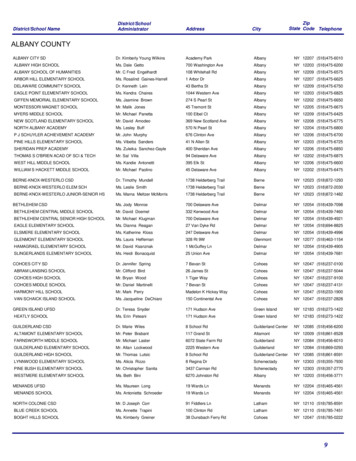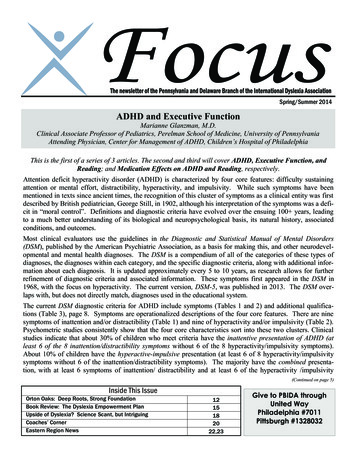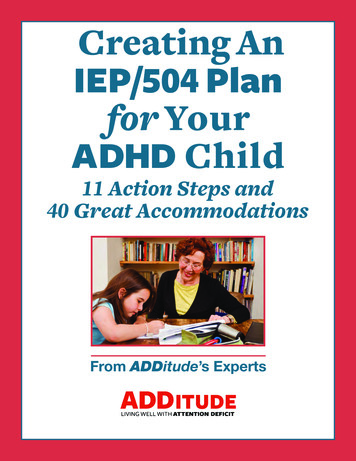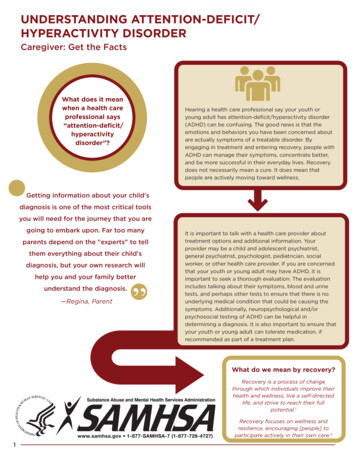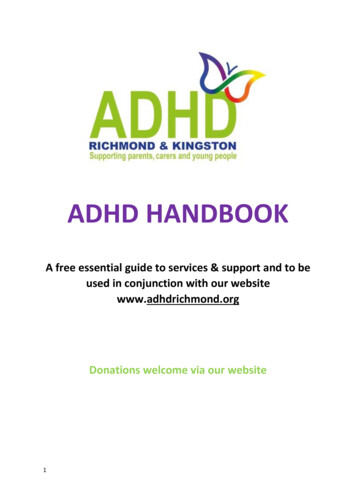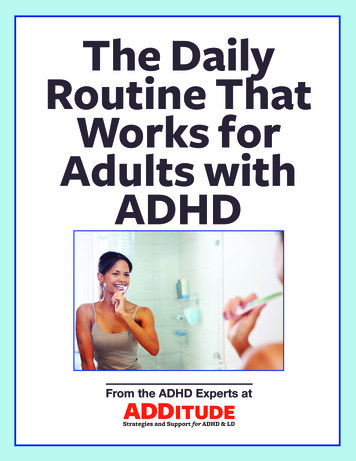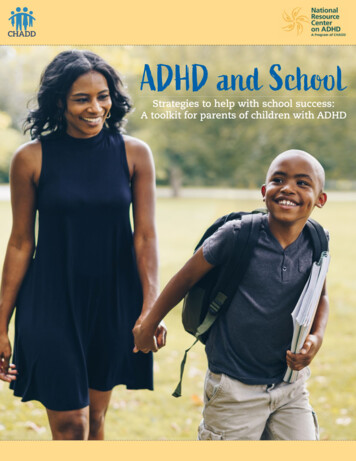
Transcription
ADHD and SchoolStrategies to help with school success:A toolkit for parents of children with ADHD
ADHD and SchoolFOR 30 YEARS, CHADD has been providing support, training, education, andadvocacy for children and adults living with ADHD and their families. We knowthat school for many children with ADHD brings a lot of challenges. This toolkitincludes resources tailored to ADHD struggles, such as how to create routines, howto set up a homework station, and how to structure home-school communication.Additional resources include customizable charts, a sample letter requesting specialeducation services, an information card for teachers on ADHD, and information on therights of students with ADHD from the U.S. Office for Civil Rights. We hope this willhelp you and your child have a successful school year.—CHADD - The National Resource on ADHDContentsCreating Morning and Afternoon Routines . . . . . . . . . . . . . . . . . . . . . . . . . . . . . . . . . . . . . . . . . . 1Morning Routine Sample (same each day) . . . . . . . . . . . . . . . . . . . . . . . . . . . . . . . . . . . . . . . 2Afternoon Routine Sample (different each day) . . . . . . . . . . . . . . . . . . . . . . . . . . . . . . . . . . . 2Setting up a Homework Station . . . . . . . . . . . . . . . . . . . . . . . . . . . . . . . . . . . . . . . . . . . . . . . . . . . . 3Home-School Communication Trackers . . . . . . . . . . . . . . . . . . . . . . . . . . . . . . . . . . . . . . . . . . . . 4Daily Behavior Tracker (Elementary grades) . . . . . . . . . . . . . . . . . . . . . . . . . . . . . . . . . . . . . . 5Weekly Behavior Tracker (Elementary and Middle School grades) . . . . . . . . . . . . . . . . . . 6Organization and Class Participation Tracker (Middle and High School grades) . . . . . . 7Sample Letter to Request an Evaluation for Special Education Services . . . . . . . . . . . . . . . . 8Additional Resources . . . . . . . . . . . . . . . . . . . . . . . . . . . . . . . . . . . . . . . . . . . . . . . . . . . . . . . . . . . . . 91. Customizable charts from this toolkit . . . . . . . . . . . . . . . . . . . . . . . . . . . . . . . . . . . . . . 10-132. CHADD’s Teacher Card: Recognizing ADHD in the Classroom / . . . . . . . . . . . . . . . . 14Strategies & Tips to Help Students with ADHD3. Know Your Rights: Students with ADHD . . . . . . . . . . . . . . . . . . . . . . . . . . . . . . . . . . . . . . 164. Fact Sheet: Restraint and Seclusion of Students with Disabilities . . . . . . . . . . . . . . . . 185. IDEA vs. Section 504 infographic . . . . . . . . . . . . . . . . . . . . . . . . . . . . . . . . . . . . . . . . . . . 206. Additional Web and YouTube Resources . . . . . . . . . . . . . . . . . . . . . . . . . . . . . . . . . . . . . . 21COVER PHOTO: ISTOCK / FRANCKREPORTER
Strategies to help with school success:A toolkit for parents of children with ADHDCreating Morning and Afternoon Routines1. Backwards planning Identify the time your child needs to be out thedoor (mornings) or the time your child needs tobe in bed (evening) Create two lists. One for tasks before schooland one for tasks after school Estimate the time for each task Plan backward from the time your child needsto be out the door or in bed2. Safety net Plan for bumps Add in extra time for breathing room3. Prep ahead (for morning routines) Do as many tasks as possible the nightor weekend before such as: Take a showerChoose clothesPrepare breakfast foodPack a backpackPack sports and activity bagsPrepare the launch/landing pad4. Prep ahead (for afternoon routines) Prepare for afternoon tasks the dayor weekend before such as: Clean off the launch/landing padPrepare snacksHave a homework space set up with all materialsCreate a visual reminder of after school rules5. Time checks along the way Break up longer time periods Use a timer or alarm to set increments for each activity Can use apps6. Ask your child for input Involve your child in developing routines Ask them how long they think things take and then havethem time themselves* Take care of your routines (getting ready in the morning or for bed at night) before or after your children if possibleSHUTTERSTOCK / NEW AFRICA1
ADHD and SchoolMorning Routine Sample (same each day)Wake up7:15–7:30Shower7:30–7:45Get dressed7:45–8:00Breakfast8:00–8:15Brush teeth, fix hair, makeup, etc.8:15–8:30Flex time8:30–8:45Out the doorISTOCK/ PHOTOEVENT7:00–7:15Afternoon Routine Sample (different each day)3:30 – 4:00MondayTuesdayWednesdayThursdayFree timeBaseballBreakHomework4:00 – 4:30WeekendHomework4:30 – 5:00Break5:00 – 5:30Dinner5:30 – 6:00ChoresBreakBreak6:00 – 6:30DinnerDinnerDinner6:30 – 7:00HomeworkChoresChoresHomeworkFree time7:00 – 7:30Baseball7:30 – 8:008:00 – 8:30Free timeFree timeChores8:30 – 9:009:00 – 9:30Free timeBedtimeBedtimeBedtimeBedtimeAdapted from the National Resource Center on ADHD: A Program of CHADD’s Ask the Expert webinar, Improve Homework Time with Strategies thatWork for ADHD, presented by Cindy Goldrich, EdM, ACAC2
Strategies to help with school success:A toolkit for parents of children with ADHDSetting up a Homework Station1. Involve your child in setting up the space to help figureout what works best for him or her early in the schoolyear. Your child can help pick the location and decoratethe area.2. Make sure the homework space has its own set ofmaterials and supplies. If possible, keep an extra set ofschool books at home.3. Provide and use a timer to help your child know thedifference between work time and break time.4. Set clear and achievable work completion goals ratherthan telling your child to work for a certain period oftime. For example, “You can take a 10 minute break assoon as you complete 20 math problems and at least15 of them are correct”.5. Pick the space so that you can keep an eye on yourchild, but aren’t hovering.6. Remove or minimize things that require direct attentionand become a distraction. Things that distract might bethe television or access to social media.7. Allow your child to use strategies that help him or herfocus, such as background noise, music with or withoutwords, or fidget toys. Try it out with your child to seewhat works.8. Some children work better if they are able to stand ormove around/walk while doing activities such as reading, memorizing, or being quizzed. Try it out with yourchild to see what works.9. Monitor throughout the year and make any adjustmentsas needed to help him or her work better.ISTOCK / PEOPLEIMAGES3
ADHD and SchoolHome-School Communication TrackersTrackers are tools that can be individualized to each student. You can work with ateacher to customize a tracker to fit the needs of your child as well as make it ageappropriate. Some ideas to keep in mind when using a tracker: ACCENTUATE the positive. Make the tracker about rewarding positive behavior, not penalizing the behavior that still needs improvement. FOCUS on 2-5 behaviors. You don’t want to overwhelm your child by listingtoo many behaviors. VARY THE DIFFICULTY of the behaviors. 1-2 might be behaviors that yourchild really struggles with, 1-2 might be behaviors could sometimes be achallenge, and 1-2 might be behaviors that they do well most of the time. Youwant to make success easy. PLAN REWARDS for improvements and success on trackers. You want rewards to be practical, motivating, and available each day after school. Workwith your child to identify rewards that are meaningful to them, not justsomething you think is a good idea. Rewards are often effective if they are related to the behavior. For example, if your child works hard to complete workquickly, they can get extra time for a fun activity. If they work hard on behaving responsibly, they can be allowed to do an activity that requires a bit morematurity, like staying up a bit longer. FINE TUNE the tracker on a regular basis. Your child’s abilities and needschange. Edit the tracker in collaboration with your child and your child’s teacher when possible. Update rewards as well.Some behaviors that could be included in a tracker are: Follows directionsStays on taskCompletes AssignmentsStays in seatKeeps hands and feet to selfWorks quietlyComes to class preparedTurns in homeworkGains the teacher’s attention appropriatelyComes to class on timeListens to others and waits for a turn to speakFollows the rulesShows respect to the teacher andother studentsAdapted from CHADD’s Parent to Parent ProgramISTOCK / MONKEYBUSINESSIMAGES4
Strategies to help with school success:A toolkit for parents of children with ADHDISTOCK / ASISEEITDaily Behavior Tracker (Pre-K and Elementary Grades)Smile complied withtwo or fewer teacherprompts8:30 – 10:1510:30 – 12:0012:40 – 1:452:00 – 3:00FollowsDirectionsStays on TaskCompletesAssignmentsCame prepared with a homework folder and planner to school.Turned in completed homework to teacher.Adapted from CHADD’s Parent to Parent Program5
ADHD and SchoolRating Scale—Circle a Number1 0–25% of time2 26–50% of timeWeekly Behavior Tracker(Elementary and middle school grades)Monday4 76–100% of timePerformance RatingStays in seat1234Works quietly (no talk outs of noises)1234Keeps hands and feet to self1234Stays on task1234TuesdayPerformance RatingStays in seat1234Works quietly (no talk outs of noises)1234Keeps hands and feet to self1234Stays on task1234WednesdayPerformance RatingStays in seat1234Works quietly (no talk outs of noises)1234Keeps hands and feet to self1234Stays on task1234ThursdayPerformance RatingStays in seat1234Works quietly (no talk outs of noises)1234Keeps hands and feet to self1234Stays on task1234FridayPerformance RatingStays in seat1234Works quietly (no talk outs of noises)1234Keeps hands and feet to self1234Stays on task1234Adapted from CHADD’s Parent to Parent Program63 51–75% of time
Strategies to help with school success:A toolkit for parents of children with ADHDRating Scale—Circle a Number1 2 or fewer days this weekWeekly Organization and Class Participation Tracker2 3 to 4 days this week3 all days this week(Middle and high school grades)—sent home on FridayBehaviorPerformance RatingComes prepared with paper, pencil, and books123Gains the teacher’s attention appropriately123Works steadily on tasks as directed by the teacher123Completes classwork on time123Homework assignments recorded accurately in planner123Homework turned in on time123SHUTTERSTOCK / MONKEYBUSINESSIMAGES7
ADHD and SchoolSample Letter to Request an Evaluation for Special Education ServicesAdapted from CHADD’s Parent to Parent ProgramSHUTTERSTOCK / ZHUKOV8
Additional Resources1. Customizable charts from this toolkit2. CHADD’s Teacher Card: Recognizing ADHD in the Classroom/Strategies & Tips to Help Students with ADHD3. Know Your Rights: Students with ADHD4. Fact sheet: Restraint and Seclusion of Students with Disabilities5. IDEA vs Section 504 infographic6. Additional Web and YouTube ResourcesSHUTTERSTOCK / MASCHA TACE9
ADHD and SchoolMorning 08:00–8:158:15–8:308:30–8:45Afternoon RoutinewMonday3:30 – 4:004:00 – 4:304:30 – 5:005:00 – 5:305:30 – 6:006:00 – 6:306:30 – 7:007:00 – 7:307:30 – 8:008:00 – 8:308:30 – 9:009:00 – 9:30Adapted from CHADD’s Parent to Parent Program10TuesdayWednesdayThursdayWeekend
Addtional ResourcesDaily Behavior Tracker (Pre-K and Elementary Grades)Smile compliedwith two or fewerteacher prompts8:30 – 10:1510:30 – 12:0012:40 – 1:452:00 – 3:00Follows DirectionsStays on TaskCompletesAssignmentsCame prepared with a homework folder and planner to school.Turned in completed homework to teacher.Adapted from CHADD’s Parent to Parent Program11
ADHD and SchoolRating Scale—Circle a Number1 0–25% of time2 26–50% of timeWeekly Behavior Tracker(Elementary and middle school grades)MondayTuesdayWednesdayThursdayFridayAdapted from CHADD’s Parent to Parent Program123 51–75% of time4 76–100% of timePerformance Rating1234123412341234Performance Rating1234123412341234Performance Rating1234123412341234Performance Rating1234123412341234Performance Rating1234123412341234
Addtional ResourcesRating Scale—Circle a Number1 2 or fewer days this weekWeekly Organization and Class Participation Tracker2 3 to 4 days this week3 all days this week(Middle and high school grades)—sent home on FridayBehaviorPerformance Rating123123123123123123Adapted from CHADD’s Parent to Parent Program13
ADHD and SchoolRECOGNIZINGADHDIN THE CLASSROOMFOR STRATEGIES & TIPS TO HELP STUDENTS WITH ADHD SEE REVERSE SIDEwww.chadd.org14
Addtional ResourcesSTRATEGIES & TIPSTO HELP STUDENTS WITH ADHDSEATING1. Away from distractionsOffer seating options such as single desks instead of two-person desks or tables; U-shapes, Eshapes, and rows (straight or staggered) often help.2. Near teacher or responsible peersTeacher can help focus attention to tasks, clarify directions. Seeing others at work can cuestudent to return to task.ORGANIZATION1. Assignment notebookMany students with ADHD have trouble remembering and tracking assignments2. Backup way to get assignmentsStudents who struggle with organization need strategies that help them complete their work inspite of their struggles.3. Teach & practice organization skillsStudents must be taught missing skills or compensatory strategies on a level that matches theiryounger developmental age.4. Notify parents of important due datesUltimately, everyone who touches a student’s life has a role to play. Regular communication isessential.CLASSROOM MANAGEMENT1. Teach and reinforce good listeningBe specific about what to do (eye contact, not interrupting). Reward good behavior. Positivereinforcement works best.2. Use procedures and routinesPractice, monitor, review, and reteach routines. Keep reviewing until it becomes a habit.3. Allow some fidget objectsFidgeting objects may help some children with ADHD focus rather than being a distraction.4. Give at least 3x more positive feedback thannegativePositive feedback is more powerful in changing behavior. It should also be specific so theyknow what behavior to repeat.INFORMATION DELIVERY1. Add written or pictorial directions to oraldirectionsStudents may miss parts of oral directions. Written or pictorial instructions help fill in the gaps.2. Use graphic organizers. Give outlines for notetakingStudents understand and remember information better when ideas, words, and concepts areassociated with pictures, diagrams, charts, and maps.3. Give multisensory instructionUse song and movement to practice spelling words. Use color to call attention to letters withthe word and to aid memory.4. Give instructions one at a timeStudents may have memory problems and may only be able to remember one step at a time.Repeating directions helps keep them in memory longer.5. Break large projects into small tasks withdeadlines for completing each taskStudents with ADHD have difficulty breaking down large projects into smaller tasks, leading toprojects that are not completed or rushed through on the night prior to due date.STUDENT WORK1. Visual prompts, cues, frequent redirection to taskUse a prearranged private signal. Ask student for input on what will work best.2. Use task cards to reinforce directionsTask cards serve as reminders. Explain to class that everyone learns differently or giveeveryone task cards to avoid stigmatizing the child with ADHD.3. Match independent assignments to studentabilitySometimes performance or skill expectations are a struggle; for example, cursive writing orreading independently.4. Shorten assignments (every other math problem,shorter spelling list)This is to compensate for the length of time it takes to complete.5. Reduce handwriting (write answers only, wordprocessor, or dictate to parent)Motor skills may not be fully developed in these students.15
ADHD and SchoolUNITED STATES DEPARTMENT OF EDUCATIONOffice for Civil RightsKnow Your Rights: Students with ADHDIf you are the parent or guardian of a student in public elementary or secondary school, including a charterschool, and that student has attention-deficit/hyperactivity disorder (ADHD), the information belowsummarizes your rights and your school district’s legal obligations under a Federal civil rights law thatprohibits disability discrimination called Section 504 of the Rehabilitation Act of 1973 (Section 504).Federal Law Protects Students from Disability Discrimination Section 504 protects any student with a disability from discrimination based on disability.Regardless of how well he or she performs in school, a student who has trouble concentrating, reading,thinking, organizing or prioritizing projects, among other important tasks, because of ADHD may have adisability and be protected under Section 504.A student with ADHD who has a disability under Section 504 may also be entitled to special educationor related aids or services from his or her school district.Your School District Must Determine if A Student Has a Disability and Needs Services Under Section 504, your school district must evaluate a student, at no cost to you, if the district believesor has reason to believe a student has a disability and needs special education and/or related servicesbecause of that disability.You can also request that the school district evaluate a student. For example, you might request anevaluation if you suspect a student has ADHD, or a student has received a diagnosis of ADHD outside ofschool.oo 16A district must either: (1) conduct the evaluation, or (2) explain why it is refusing to evaluate thestudent and notify you of your right to dispute that decision through the due process proceduresunder Section 504.During an evaluation process, you can, but are not required to, provide information to the schoolto consider before an evaluation.Signs that a student may need an evaluation could be: considerable restlessness or inattention; troubleorganizing tasks and activities; communication or social skill deficits; or significant difficulty related tobeginning a task, recalling information, or completing assignments.Your school district must determine if an evaluation is necessary even if a student exhibits behavioral(and not academic) challenges.If the school district suspects a student has a disability, the district cannot deny or delay this disabilityevaluation in order to first provide the student with intervention strategies.If your school district requires, as part of the evaluation, a medical assessment to determine whether astudent has ADHD, the school district must ensure that the student receives this assessment at no costto you.July 2016Page 1
Addtional ResourcesUNITED STATES DEPARTMENT OF EDUCATIONOffice for Civil Rights When conducting the disability evaluation, your school district cannot consider the positive effects ofmitigating measures in determining if a student has a disability. For example, if your daughter usesmedication to address ADHD, the school district cannot consider the positive effects of that medicationas a basis to determine she does not have a disability.A Student May Be Entitled to Individualized Services to Meet His or Her Needs All elementary and secondary school students who are individuals with disabilities as defined bySection 504 are entitled to a free appropriate public education (FAPE). Under Section 504, FAPE is theprovision of regular or special education and related aids and services designed to meet a student’seducational needs as adequately as the needs of students without disabilities are met.School districts often set forth these needed services in a document, typically referred to as a “Section504 Plan.”o The school district cannot limit FAPE to those aids or services that are free or low-cost, andcannot exclude needed aids and services just because of their expense.Not every student with ADHD needs the same set of services, or any services at all. School districtscannot simply provide the same aids and services to all students with ADHD. Each student’s needs maybe different, and Section 504 requires school districts to provide for those individual educational needs.The special education or related aids and services that are included in a student’s Section 504 Plan, orsimilar document, should be clear and detailed so that you and the school both understand what theplan requires, and can make sure it is implemented consistently.Your School District Must Provide You with Due Process Under Section 504 The school district must allow you to appeal district actions regarding the identification, evaluation, oreducational placement of a student with a disability. This obligation is more commonly known as “dueprocess.”The school district must tell you about this due process system, notify you of any evaluation orplacement actions, allow you to examine the student’s records, provide you an impartial hearing, allowyou to have a lawyer at that hearing, and provide you a review procedure.ResourcesTo learn more about a school district’s Section 504 obligation to provide FAPE to students with ADHD,please see OCR’s July 2016 Dear Colleague Letter and Resource Guide, s/colleague-201607-504-adhd.pdf, and visit OCR’swebsite, at www.ed.gov/ocr.If you want to learn more about your rights, or if you believe that your school is violating Federal law, youmay contact the U.S. Department of Education, Office for Civil Rights, at (800) 421-3481, (800) 877-8339(TDD), or ocr@ed.gov. You may also file a complaint online at www.ed.gov/ocr/complaintintro.html.Page 2 of 217
ADHD and SchoolUNITED STATES DEPARTMENT OF EDUCATIONOffice for Civil RightsFact Sheet: Restraint and Seclusion of Students with DisabilitiesWhat Is the Dear Colleague Letter on Restraint and Seclusion?The guidance letter and series of questions and answers, issued by the Department of Education’s Officefor Civil Rights (OCR) on December 28, 2016, inform school districts how the use of restraint andseclusion may result in discrimination against students with disabilities in violation of Federal laws thatprohibit disability discrimination, including Section 504 of the Rehabilitation Act of 1973 (Section 504).Why did OCR Issue this Guidance?According to the Department’s Civil Rights Data Collection CRDC, during the 2013-14 school year,students with disabilities were subjected to mechanical and physical restraint and seclusion at ratesthat far exceeded those of other students. The existence of this disparity raises a question as to whetherschool districts are imposing restraint or seclusion in discriminatory ways. In addition, OCR continuesto see in investigations legal violations in schools’ use of restraint and/or seclusion for students withdisabilities. OCR is issuing the guidance to help educators, parents, students, and other stakeholdersbetter understand Section 504, and how the use of restraint or seclusion may run afoul of the law.What does Federal law require school districts to do for students with disabilities?The guidance explains that Section 504 requires a school district to provide students with disabilities anequal opportunity to participate in the educational program and to provide a free appropriate publiceducation (FAPE) to each student with a disability. To meet the FAPE requirement, school districts mustevaluate any student who needs, or whom the district has reason to believe needs, special education orrelated services because of a disability.A student’s behavioral challenges, such as those that lead to an emergency situation in which a schoolbelieves restraint or seclusion is a justified response could be a sign that the student actually has adisability and needs special education or related aids and services in order to receive FAPE. When astudent exhibits behavior that interferes with the student’s education, or the education of otherstudents, in a manner that would reasonably cause a teacher or other school personnel to believe orsuspect that the student has a disability, the school district must evaluate the student.Can the use of restraint or seclusion deny a student’s receipt of Section 504 FAPE?Yes. A school’s use of restraint or seclusion may have a traumatic impact on a student, such that even ifshe were never again restrained or secluded, she might nevertheless have new academic or behavioraldifficulties that, if not addressed promptly, could constitute a denial of FAPE. That traumatizing effectcould manifest itself in new behaviors, impaired concentration or attention in class, or increasedabsences, any of which could, if sufficiently severe and unaddressed, result in a denial of FAPE for thatstudent.The repeated use of restraint or seclusion in school could deny a student’s receipt of FAPE in anotherway. Consider a student with a disability who engages in behavior in response to which the schoolsecludes him for extended periods and on multiple occasions. While secluded, the student does not18December 2016Page 1 of 2
Addtional ResourcesUNITED STATES DEPARTMENT OF EDUCATIONOffice for Civil Rightsreceive educational instruction or services. Cumulatively, the school’s repeated use of seclusion withthat student could result in the school’s failure to comply with the Section 504 team’s decision about theregular or special education, related aids and services, or supplemental services and modifications thatthe student needs, or the appropriate setting in which to receive those services, and therefore mayconstitute a denial of FAPE.Where the school determines that not all of the student’s educational needs are being met, the schoolmust (1) determine the extent to which additional or different interventions or supports and services,including positive behavioral interventions and supports and other behavioral strategies, may beneeded; (2) determine if current interventions and supports are being properly implemented; (3)ensure that any needed changes are made promptly; and (4) remedy any denial of FAPE that resultedfrom the school’s prior use of restraint or seclusion.Does the parent or guardian of a student with a disability have a right to discuss the impact ofrestraint or seclusion on their child’s access to FAPE?Yes. Section 504 requires that school districts establish and implement a system of proceduralsafeguards for parents or guardians to appeal district actions regarding the identification, evaluation, oreducational placement of students with disabilities who need or are believed to need special educationor related services. The school district must tell parents and guardians about this system, notify them ofany evaluation or placement actions, allow them to examine their child’s records, afford them animpartial hearing with opportunity for parent or guardian participation and representation by counsel,and provide them a review procedure.How Can I Get Help From OCR? Requesting More Information. With questions or for more information, including technicalassistance on civil rights compliance, please contact the U.S. Department of Education’s Office forCivil Rights (OCR) customer service team at 1-800-421-3481 (TDD 1-800-877-8339) orocr@ed.gov or visit OCR’s website at www.ed.gov/ocr.Filing a Complaint. Anyone who believes that a school that receives Federal financial assistancehas discriminated against someone based on race, color, national origin, sex, disability, or age,can file a complaint of discrimination with OCR within 180 days of the alleged discrimination.The person or organization filing the complaint need not be a victim of the allegeddiscrimination, but may complain on behalf of another person or group. For more details, pleasevisit www.ed.gov/ocr/complaintintro.html or contact OCR’s customer service team at 1-800421-3481 (TDD 1-800-877-8339).December 2016Page 2 of 219
IDEA SSection 504ADHD and SchoolWhat are they? Laws that provide special education, other services, andappropriate accommodations for eligible children with disabilities in theUnited States.National ResourceCenter onSectionADHD504IDEAWhat is the legal difference?National ResourceCenter on ADHDA civil rights statute requiring allrecipients of federal funds to providenon-discriminatory services, includingreasonable accommodationsA funding statute requiringall states to follow itsconditions for fundingspecial educationWhere does it apply?SS IDEAIDEAIDEASection504Section 504All federally fundedprograms, which includesall public schools.All state and local publicschool districts.National ResourceCenter on ADHDWho does it cover?Section 504categories ofdisabilities. Childrenmust be eligible underat least one category SAnychild with an identifiedphysical or mental disabilityWhat are they? Laws that provide special education, other services, andWhat about ADHD?appropriate accommodations for eligible children with disabilities in theFallsunderthe“otherhealthimpairment”If ADHD substantially limits aWhat are they? Laws that provide special education, other services, andcategory. Kids with ADHD in some cases aremajor life activity, such asappropriate accommodations for eligible children with disabilities in theUnited States.eligible under the “emotional disorder” and“learning disability” categories.United States.learning, then a child qualifiesfor services.What are they? Laws that provide special education, other services, andmakeschild eligible?What is theaccommodationslegaldifference?appropriatefor
Homework assignments recorded accurately in planner 1 2 3 Homework turned in on time 1 2 3 Rating Scale—Circle a Number 1 2 or fewer days this week 2 3 to 4 days this week 3 all days this week Strategies to help with scho
